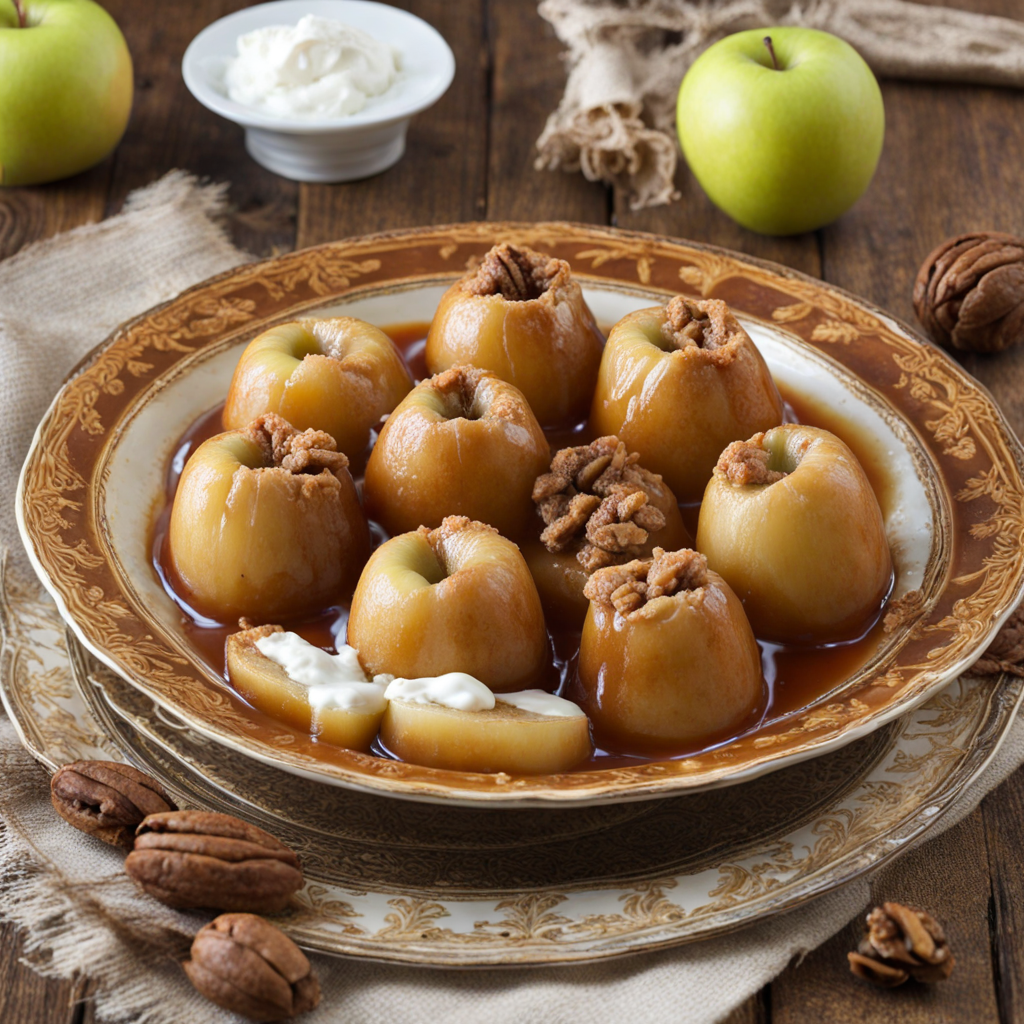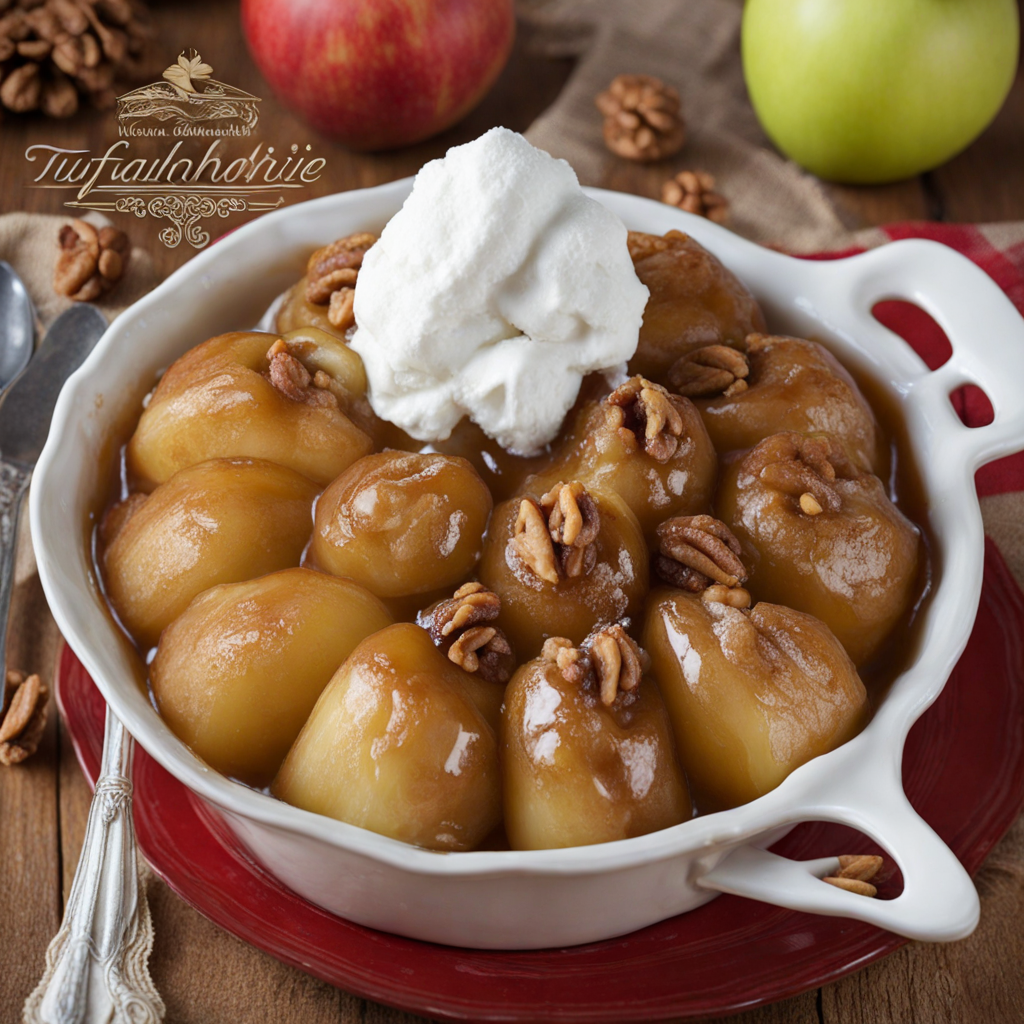Tufahije
Tufahije is a delightful Montenegrin dessert that embodies the rich culinary traditions of the Balkans. This indulgent sweet treat features poached apples, which are meticulously hollowed out and stuffed with a luscious mixture of ground walnuts, sugar, and aromatic spices such as cinnamon. The apples are gently cooked until tender, allowing their natural sweetness to enhance the nutty filling, creating a harmonious blend of textures and flavors that is both comforting and satisfying. The dessert is often drizzled with a syrup made from the poaching liquid, adding a glossy sheen and an extra touch of sweetness to each bite. The presentation of Tufahije is as inviting as its taste. Once plated, the poached apples resemble little jewel-like treasures, often garnished with crushed nuts or a sprinkle of cinnamon to add visual appeal. The contrast between the soft, warm apple and the crunchy walnut filling creates a delightful mouthfeel that keeps each bite interesting. It’s a dish that not only satisfies the sweet tooth but also evokes a sense of nostalgia, reminiscent of homemade desserts passed down through generations. This traditional dessert is often enjoyed during festive occasions and family gatherings in Montenegro, making it a symbol of hospitality and love. Whether served warm or chilled, Tufahije invites diners to savor its layered flavors and rich history. For those seeking to explore new tastes, this exquisite dessert offers a unique glimpse into Montenegrin culture, showcasing the beauty of simple ingredients transformed into a culinary masterpiece.
How It Became This Dish
The Sweet Legacy of Туфахије: A Culinary Journey through Montenegro #### Origin and Historical Context Туфахије, a traditional Montenegrin dessert, is a delightful representation of the region's rich culinary heritage. Derived from the Turkish word “tufahiye,” which means “apple,” this dessert showcases the country’s historical ties with Ottoman culture and the incorporation of local ingredients. Its roots can be traced back to the 15th century when the Ottomans expanded their empire into the Balkans, bringing along their culinary practices and ingredients. Originally, Туфахије consisted of poached apples filled with a mixture of nuts, sugar, and spices, simmered in syrup. The choice of apples reflects Montenegro's agricultural landscape, where various apple cultivars thrive in the fertile valleys and mountainous terrains. Apples were not only a staple fruit but also a symbol of prosperity and abundance, making them an ideal base for desserts. #### Ingredients and Preparation The preparation of Туфахије has evolved over the centuries, but its essence remains rooted in simplicity and seasonal availability. The main ingredients typically include: - Apples: The variety can range from tart to sweet, depending on local harvests. - Nuts: Walnuts are most common, but hazelnuts or almonds can also be used, reflecting the region’s nut cultivation. - Sugar and Spices: Sugar enhances the sweetness, while spices like cinnamon and cloves add aromatic depth. - Syrup: A syrup made from sugar and water, sometimes flavored with lemon or rose water, is used to poach the apples. The preparation process involves carefully hollowing out the apples, mixing the nut filling, and poaching the fruit until tender. The final touch is often a drizzle of syrup, making it an attractive centerpiece for any gathering. #### Cultural Significance Туфахије is not just a dessert; it holds cultural significance within Montenegro. It is often served during special occasions such as weddings, religious holidays, and family gatherings. The dish embodies hospitality, a key element of Montenegrin culture. Offering Туфахије to guests signifies warmth and generosity, reinforcing the bonds of community and family. Moreover, Туфахије represents a blend of cultures in Montenegro. The Ottoman influence can be seen in its preparation and presentation, while the use of local ingredients highlights the connection to Montenegrin agricultural practices. This combination reflects the diverse history of the region, where various ethnic groups have coexisted, each contributing to the culinary landscape. #### Evolution Over Time As Montenegro underwent significant political and social changes over the centuries, so too did its culinary practices. During the 20th century, particularly in the post-World War II era, traditional dishes like Туфахије began to adapt to modern tastes and lifestyles. The rise of tourism in Montenegro brought with it a renewed interest in traditional foods, and Туфахије found its way onto restaurant menus, often with a contemporary twist. Chefs started experimenting with the classic recipe, incorporating various flavors and presentations. Some introduced chocolate or caramel elements, while others played with the concept of deconstruction, presenting the components of the dish in innovative ways. Despite these modern adaptations, the fundamental spirit of Туфахије remains intact. #### The Role of Туфахије in Modern Montenegrin Cuisine Today, Туфахије is celebrated not only as a dessert but also as a symbol of national pride. Culinary festivals and events across Montenegro often feature this dish, showcasing its importance in the local food culture. Beyond its borders, Туфахије has gained recognition in culinary circles as a representative of Balkan desserts, drawing attention to the rich flavors and traditions of the region. In contemporary Montenegrin households, Туфахије continues to be a beloved treat, often prepared during family gatherings or festive occasions. The recipe is passed down through generations, each family adding their personal touch, ensuring that the tradition is preserved while allowing for creativity. This intergenerational transmission of culinary knowledge is vital for maintaining the cultural identity of Montenegro. #### Conclusion: A Sweet Symbol of Heritage Туфахије encapsulates the essence of Montenegro’s culinary heritage. It is a dish that tells the story of the land, its people, and their shared history. From its Ottoman origins to its place in modern Montenegrin cuisine, Туфахије serves as a reminder of the beauty of cultural exchange and the importance of preserving traditional practices. As Montenegro continues to evolve in the global culinary scene, Туфахије stands as a sweet testament to the country’s rich past and promising future. Whether enjoyed at a festive gathering or as a comforting family dessert, Туфахије remains a cherished recipe that connects Montenegrins to their roots while inviting others to share in their flavorful journey. In a world that often prioritizes speed and convenience, the careful preparation and presentation of Туфахије remind us to savor not just the flavors, but also the stories and traditions that shape our culinary experiences.
You may like
Discover local flavors from Montenegro







